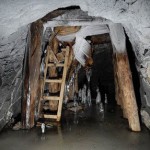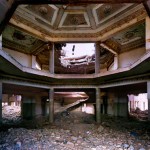 |
| 17-year-old Mariam leads her family’s caravan through the foothills of the Himalayas, while carrying her 2-year-old niece in the blue plaid shawl over her shoulders. |
The forests and mountains of north India are home to a unique nomadic tribe whose world revolves around caring for the water buffaloes that they herd. During the fall and winter months, the Van Gujjars dwell in the lowland jungles of the Shivalik Hills, where thick foliage provides plenty of fodder for their animals at that time of year. But by mid-April, as temperatures there soar above 110 degrees, the leaves and grasses wither and die and creeks and streams run dry. With nothing left for their buffaloes to eat or drink, the Van Gujjars must move elsewhere.
Entire families, from infants to the elderly, trek with their herds up into the Himalayas, where melting snows reveal lush alpine meadows laced by gurgling streams, which provide abundant grass and water throughout the summer. When the cold sets in at the end of September, they head back down to the Shivaliks, where the jungle has sprung back to life following the monsoon rains. The tribe has followed this cycle of seasonal migration—up in summer, down in winter, perpetually living in the wilderness and shunning settled village life—for over 1,500 years.
My most recent book, Himalaya Bound: One Family’s Quest to Save Their Animals – And an Ancient Way of Life, which was published by Pegasus Books earlier this year, follows one extended Van Gujjar family on their spring migration into the mountains. In this article, I’ll delve into the story behind the images that are featured in the book’s photo insert, which is sandwiched between 230 pages of text.
 |
Who Am I?
I’m a freelance photographer and writer for magazines and newspapers, including The New York Times. I’m also the author of three books.
I often find myself drawn to stories about nomadic communities around the world—for my first book, Men Of Salt: Crossing the Sahara on the Caravan of White Gold, I traveled 1,000 miles over age-old trade routes north of Timbuktu with one of the last working camel caravans on Earth. I’ve spent time with nomadic / transhumant people in Africa, the Middle East, a number of states in India, as well as Mongolia and the Southwestern U.S.
Before taking on the project that became Himalaya Bound, I had dreamed of migrating with a tribe—partly to document what is becoming an increasingly rare way of life, and partly because I imagined it would be an amazing thing to experience.
 |
| The Van Gujjars’ livelihoods are based almost entirely on the sale of buffalo milk |
Planning
No, I did not fly over to India, wander into the jungle, and start randomly knocking on huts asking Van Gujjars if I could migrate with them. As the idea for this project began to crystallize in my mind, it seemed wise to investigate how realistic it was to pursue before channeling too much time, money, and energy in its direction.
My first step was emailing the director of the Society for the Preservation of Himalayan Indigenous Activities (SOPHIA)—a small non-profit organization based in Dehradun, India, that advocates for the tribe—asking if he thought it would be possible for me to travel with a nomadic family and document their migration from beginning to end. He replied that he would check in with a few Van Gujjars to see if they were open to the idea. As it turned out, they were; since they were being pressured by the government to abandon their way of life against their will, they thought it might be helpful if someone would share their story with the rest of the world. SOPHIA also connected me with a translator who was willing to join me for most of the journey.
Gear
My choice of camera gear was determined by three factors: weight, budget, and year. The year was 2009 and I had to watch what I spent. But my main consideration was the fact that I was embarking on an assignment during which I would be trekking for over a month, from the lowlands into the Himalayas, while hauling everything I needed on my back—including a sleeping bag, clothing appropriate for temperatures ranging from over 110 degrees to below freezing, a first aid kit, and more. Thus, my goal was to make the most out of as little camera gear as I could carry and still get satisfying images.
I ended up taking a Nikon D90 (remember the year) with a few Nikon lenses: an 18-70mm zoom, plus 50mm F1.4 and 35mm F1.8 primes. I kept my old Nikon D70 in the bottom of my bag as a backup in case the D90 failed (it never did), and I brought along a low-quality but very lightweight tripod. Knowing that I might spend days or weeks without an electrical outlet, I also carried a bunch of batteries.
 |
The prime lenses proved to be crucial: many days, we hit the trail by 3am, aiming to arrive at our next camp as early in the morning as possible. This meant that my best shooting opportunities on the trail were often during the liminal hours in weak light around the break of dawn. With the caravan marching forward, I had to get shutter speeds fast enough to stop motion, and the only way to do that was with wide apertures—often shooting at F2. Carrying my fully loaded backpack, I would run ahead of the family, pause, turn, shoot, and repeat, as they quickly caught up to me.
 |
| Hamju carries his nephew, Karim |
 |
| Goku carries her brother, Yasin, while following the Yamuna River into the Himalayas. |
Getting the Images
The most important element in the series of images I returned with was the time I spent deep in the Van Gujjars’ world. I lived with them for forty-four days: walking with them, herding buffaloes with them, swimming in rivers with them, joking around with them, helping with daily chores, and sleeping under their tents. I formed real relationships with my companions, which I think accounts for how natural they appear and how clearly their personalities are communicated through the images.
I never set up shots or posed anyone—I either snapped away while they were doing whatever they happened to be doing or, for true portraits, they presented themselves however they liked.
 |
| The heads of four Van Gujjar families discuss their strategy for moving higher into the Himalayas, after the government has threatened to ban them from their ancestral alpine meadows, where they have gone each summer for generations, because those meadows are now within a national park. They scrambled to find a different place to spend the summer. |
 |
| Jamila cooks lunch on the trail, with her 2-year-old son Yasin on her lap. |
 |
| Mustooq and his little cousins, Bashi and Salma, asked for their picture to be taken. |
 |
| Dhumman, the father of the family I traveled with, wanted a photo with his favorite buffalo. |
Of course, the time I spent immersed with the tribe also allowed me to witness—and shoot—the scenarios that were essential to telling their story, as they happened.
One part of the Van Gujjars’ culture that I needed to capture was the deeply personal connection that they have with their water buffaloes. They think of their large horned animals as family members, and readily sacrifice their own comfort for their herds. If a buffalo falls ill, Van Gujjars become wracked with concern; if one dies, they mourn for it as though it were human. They never eat their buffaloes nor sell them for slaughter, using them only for the milk that they produce. (Though they are Muslim, Van Gujjars are also traditionally vegetarian, averse to the idea of killing animals.)
In order to get photos that convey this relationship in a way that was organic and authentic and not staged, I had to be there during those moments when that kind of closeness was demonstrated, and my companions had to be comfortable enough with me around so the fact that a foreigner with a camera was taking pictures didn’t alter the moment for them.
 |
| Goku pets one of her family’s buffaloes, at about 10,500’ above sea level. |
 |
| Sharafat dries off after a swim in the Yamuna River, trusting a buffalo enough to use it as a lounge chair. |
 |
| Karim gets his milk straight from the source. |
 |
| Bashi watches the herd at a camp in the mountains. |
In the course of documenting the migration, unexpected issues arose. While covering the human rights aspect of the story, I learned that the government was threatening to ban a number of Van Gujjar families—including the one that I was traveling with—from their ancestral alpine meadows, where they had spent summers for many generations. Those meadows had been absorbed into a national park, and park authorities didn’t want the nomads using them any longer. The Forest Department announced that any Van Gujjars who entered the park would be arrested and have their herds seized—while refusing to offer them any alternative pastures.
This left these families deeply shaken, facing dire circumstances, because they had no idea where they would take their buffaloes for the season. Hence, when the father of the family I was with joined about 80 of his fellow tribespeople at Forest Department headquarters in Dehradun (about two hours by bus from where we were camped) to plead with park officials to let them go to their traditional pastures, I went to take pictures.
Though I did nothing more than photograph what was a very peaceful scene, the park director had me arrested for being a “foreign political agitator,” and when I objected I was forced into a police car at gunpoint. Fortunately, no one thought to demand my memory cards, and the captain at the police station released me relatively quickly, realizing that the charge was absurd. What could have been a nightmare turned into a gift: by the time I rejoined the Van Gujjars that night, word about the incident had spread among the tribe, so even people I hadn’t yet met trusted me by my reputation, knowing that I had been pushed around by the same person who was pushing them around.
Weeks later, another episode posed a photographic dilemma for me. While camped at about 10,000 feet above sea level, a cataclysmic Himalayan storm struck, during which a tree washed over a cliff and landed on several young buffaloes, crushing one’s front left leg. A broken bone stuck out of the yearling’s flesh and the hoof below it flopped around like it was attached by a rubber band. It was bad, really bad, and because of how close they feel to their animals, everyone in the family was devastated—even the men were weeping.
Watching this unfold, part of me was aching to take pictures of this scene. But another part of me felt that in this moment of raw anguish, it could be the wrong thing to do: that the snapping of a shutter could create a self-consciousness that would inhibit my companions’ experience and their expressions of suffering and vulnerability.
 |
| Bashi comforts the yearling with the broken leg |
I vividly remember a photograph that once appeared on the front page of a major American newspaper, probably twenty years ago or so: it was taken at a funeral, I believe in England, after some horrible tragedy. I don’t recall the specific circumstances—what stood out to me was that one of the graveside mourners depicted in the image was looking at the camera dead-on, and using her fully extended middle finger either to wipe a tear, or to convey a not-so-subtle message to the photographer. It was hard not to imagine it was the latter.
I think it matters how taking someone’s picture makes them feel, and I try to weigh how important it is to get any one image if the taking of that image might be hurtful or disrespectful in some way. There are an array of factors to consider in what can be a split-second decision, but I do think it’s worth questioning how many photos the world needs of grieving people in tears. Surely we need some, but how often do those photos serve a larger purpose—such as provoking outcry against genocide or bringing aid to famine victims or filling in a crucial piece of an important story—and how often might those images be, say, a photojournalistic cliché?
In the particular dilemma that I faced, I decided the world’s need for photos of this family in their moment of distress was outweighed by what I perceived to be the family’s need to freely express their feelings without a camera clicking around them. I felt as though shooting right then would have been greedy—as though I would have been willing to make people I cared about feel uncomfortable so I could return with a photo of their suffering. I kept my lens cap on until a semblance of composure returned, hoping that perhaps there is some kind of photographer’s karma, which would reward me with even better shooting opportunities for letting this one pass by.
I don’t claim any moral high ground for making that choice. It was simply the right choice for me, in that moment. I’ve talked to a number of photographers who adamantly disagree with my decision, and I understand and respect their opinions even if I don’t share them. Of course, since I’m a writer as well as a photographer, I knew that I could always write about the scene later, creating a deeply moving image with words, thus telling the story without disturbing the moment as it was happening. And a couple of days later, I felt like I did receive a bit of the photographic-karmic reward I’d hoped for.
 |
| The family decided to save the yearling, splinting its leg and carrying it up and over a 3000-foot-tall Himalayan pass to the meadow where they would spend the summer. |
 |
| This was one of the most incredible things I’ve ever seen. And they did it not because the animal was worth much money, but because they love their buffaloes and would never leave one behind if there was any chance of saving it. |
After the Migration
I’ve been back to visit the family I traveled with a few times over the years since the migration. Once, I was lucky enough to catch them on their way back down from the Himalayas, and was able to join them for a few days on the road.
Though I had given them many prints of the pictures I took, it wasn’t until 2016 that any Van Gujjars got a real taste of what I was doing with this story. That year, a set of my photos from the migration was exhibited in New Delhi at the Indira Gandhi National Centre for the Arts, and I gave a slide show at the opening. A few people from the tribe had been invited to attend, and though none of my companions were able to come, some of their cousins did.
The presentation was translated into Hindi as I gave it, and afterwards one of the Van Gujjars asked for the microphone and told the audience, “This is our life!” saying he was very happy that their story was being told. It was the most satisfying form of validation that my work on this project could have received.
 |
Michael Benanav writes and shoots for The New York Times, Sierra, Geographical, The Christian Science Monitor Magazine, Lonely Planet, and other publications. His photographs have been used by international non-profit organizations and featured in National Geographic Books, on CBS’ 60 Minutes, at Lincoln Center in New York, and in exhibition at the Indira Gandhi National Center for the Arts in New Delhi.
To see more of his work, visit www.michaelbenanav.com. To see more about his new book, Himalaya Bound: One Family’s Quest to Save Their Animals – And an Ancient Way of Life, visit www.himalayabound.com.
Articles: Digital Photography Review (dpreview.com)


























You must be logged in to post a comment.